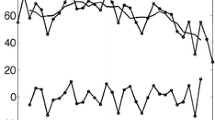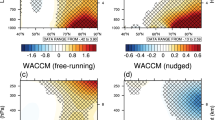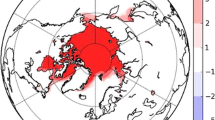Abstract
To better understand the dynamical mechanism that accounts for the observed lead-lag correlation between the early winter Barents–Kara Sea (BKS) sea ice variability and the later winter midlatitude circulation response, a series of experiments are conducted using a simplified atmospheric general circulation model with a prescribed idealized near-surface heating over the BKS. A prolonged effect is found in the idealized experiments following the near-surface heating and can be explicitly attributed to the stratospheric pathway and the long time scale in the stratosphere. The analysis of the Eliassen-Palm flux shows that, as a result of the imposed heating and linear constructive interference, anomalous upward propagating planetary-scale waves are excited and weaken the stratospheric polar vortex. This stratospheric response persists for approximately 1–2 months accompanied by downward migration to the troposphere and the surface. This downward migration largely amplifies and extends the low-level jet deceleration in the midlatitudes and cold air advection over central Asia. The idealized model experiments also suggest that the BKS region is the most effective in affecting the midlatitude circulation than other regions over the Arctic.










Similar content being viewed by others
References
Baldwin MP, Stephenson DB, Thompson DWJ, Dunkerton TJ, Charlton AJ, O’Neill A (2003) Stratospheric memory and skill of extended-range weather forecasts. Science 301:636–640. doi:10.1126/science.1087143
Barnes EA (2013) Revisiting the evidence linking Arctic amplification to extreme weather in midlatitudes. Geophys Res Lett 40(17):4734–4739. doi:10.1002/grl.50880
Barnes EA, Screen JA (2015) The impact of Arctic warming on the midlatitude jet-stream: Can it? Has it? Will it? Wiley Interdiscip Rev Clim Change 6(3):277–286. doi:10.1002/wcc.337
Butler A, Thompson D, Heikes R (2010) The steady-state atmospheric circulation response to climate change–like thermal forcings in a simple general circulation model. J Clim 23:3474–3496
Cavalieri DJ, Parkinson CL, Gloersen P, Zwally HJ (1996) Sea ice concentrations from Nimbus-7 SMMR and DMSP SSM/I-SSMIS passive microwave data. National Snow and Ice Data Center. Boulder
Cohen J., Screen JA, Furtado JC et al (2014) Recent Arctic amplification and extreme mid-latitude weather. Nat Geosci 7(9):627–637. doi:10.1038/ngeo2234
Dee DP et al (2011) The ERA-Interim reanalysis: configuration and performance of the data assimilation system. Q J R Meteorolog Soc 137(656):553–597. doi:10.1002/qj.828
Deser C, Magnusdottir G, Saravanan R, Phillips A (2004) The Effects of North Atlantic SST and sea ice anomalies on the winter circulation in CCM3. Part II: direct and indirect components of the response. J Clim 17(5):877–889. doi:10.1175/1520-0442(2004)017<0877:TEONAS>2.0.CO;2
Edmon HJ, Hoskins BJ, McIntyre ME (1980) Eliassen-Palm cross sections for the troposphere. J Atmos Sci 37(12):2600–2616. doi:10.1175/1520-0469(1980)037<2600:EPCSFT>2.0.CO;2
Francis JA, Vavrus SJ (2012) Evidence linking Arctic amplification to extreme weather in mid-latitudes. Geophys Res Lett 39(6):L06801. doi:10.1029/2012GL051000
Garfinkel CI, Hartmann DL, Sassi F (2010) Tropospheric precursors of anomalous northern hemisphere stratospheric polar vortices. J Clim 23(12):3282–3299. doi:10.1175/2010JCLI3010.1
Hartley DE, Villarin JT, Black RX, Davis CA (1998) A new perspective on the dynamical link between the stratosphere and troposphere. Nature 391(6666):471–474
Hassanzadeh P, Kuang Z (2015) Blocking variability: Arctic amplification versus Arctic oscillation. Geophys Res Lett. doi:10.1002/2015GL065923 (2015GL065923)
Hassanzadeh P, Kuang Z, Farrell BF (2014) Responses of midlatitude blocks and wave amplitude to changes in the meridional temperature gradient in an idealized dry GCM. Geophys Res Lett 41(14):5223–5232. doi:10.1002/2014GL060764
Held IM, Suarez MJ (1994) A proposal for the intercomparison of the dynamical cores of atmospheric general circulation models. Bull Am Meteorol Soc 75(10):1825–1830. doi:10.1175/1520-0477(1994)075<1825:APFTIO>2.0.CO;2
Honda M, Inoue J, Yamane S (2009) Influence of low Arctic sea ice minima on anomalously cold Eurasian winters. Geophys Res Lett 36(8):L08707. doi:10.1029/2008GL037079
Jaiser R, Dethloff K, Handorf D (2013) Stratospheric response to Arctic sea ice retreat and associated planetary wave propagation changes. Tellus A 65:19375. doi:10.3402/tellusa.v65i0.19375
Kim B-M, Son S-W, Min S-K, Jeong J-H, Kim S-J, Zhang X, Shim T, Yoon J-H (2014) Weakening of the stratospheric polar vortex by Arctic sea-ice loss. Nat Commun. doi:10.1038/ncomms5646
Koenigk T, Caian M, Nikulin G, Schimanke S (2016) Regional Arctic sea ice variations as predictor for winter climate conditions. Clim Dynam 46(1):317–337. doi:10.1007/s00382-015-2586-1
Kug J-S, Jeong J-H, Jang Y-S, Kim B-M, Folland C K, Min S-K, Son S-W (2015) Two distinct influences of Arctic warming on cold winters over North America and East Asia. Nat Geosci 8(10):759–762. doi:10.1038/ngeo2517
Kushner PJ, Polvani LM (2004) Stratosphere–troposphere coupling in a relatively simple AGCM: the role of eddies. J Clim 17(3):629–639
Kushner PJ, Polvani LM (2006) Stratosphere–troposphere coupling in a relatively simple AGCM: impact of the seasonal cycle. J Clim 19(21):5721–5727. doi:10.1175/JCLI4007.1
Lee M-Y, Hong C-C, Hsu H-H (2015) Compounding effects of warm sea surface temperature and reduced sea ice on the extreme circulation over the extratropical North Pacific and North America during the 2013–2014 boreal winter. Geophys Res Lett 42(5):2014GL062956. doi:10.1002/2014GL062956
Li C, Stevens B, Marotzke J (2015) Eurasian winter cooling in the warming hiatus of 1998–2012. Geophys Res Lett 42(19):2015GL065327. doi:10.1002/2015GL065327
McCusker KE, Fyfe JC, Sigmond M (2016) Twenty-five winters of unexpected Eurasian cooling unlikely due to Arctic sea-ice loss. Nature Geosci 9(11):838–842
Mori M, Watanabe M, Shiogama H, Inoue J, Kimoto M (2014) Robust Arctic sea-ice influence on the frequent Eurasian cold winters in past decades. Nat Geosci 7(12):869–873. doi:10.1038/ngeo2277
Nakamura T, Yamazaki K, Iwamoto K, Honda M, Miyoshi Y, Ogawa Y, Tomikawa Y, Ukita J (2016) The stratospheric pathway for Arctic impacts on midlatitude climate. Geophys Res Lett. doi:10.1002/2016GL068330 (2016GL068330)
Overland J, Francis JA, Hall R, Hanna E, Kim S-J, Vihma T (2015) The melting Arctic and midlatitude Weather patterns: are they connected? J Clim 28(20):7917–7932. doi:10.1175/JCLI-D-14-00822.1
Pedersen RA, Cvijanovic I, Langen PL, Vinther BM (2016) The impact of regional Arctic Sea ice loss on atmospheric circulation and the NAO. J Clim 29:889–902
Perlwitz J, Harnik N (2003) Observational evidence of a stratospheric influence on the troposphere by planetary wave reflection. J Clim 16:3011–3026
Petoukhov V, Semenov VA (2010) A link between reduced Barents–Kara sea ice and cold winter extremes over northern continents. J Geophys Res Atmos 115(D21):D21111. doi:10.1029/2009JD013568
Polvani LM, Kushner PJ (2002) Tropospheric response to stratospheric perturbations in a relatively simple general circulation model. Geophys Res Lett 29(7):18-11-18-14. doi:10.1029/2001GL014284
Polvani LM, Waugh DW (2004) Upward wave activity flux as a precursor to extreme stratospheric events and subsequent anomalous surface weather regimes. J Clim 17(18):3548–3554. doi:10.1175/1520-0442(2004)017<3548:UWAFAA>2.0.CO;2
Reynolds RW, Rayner NA, Smith TM, Stokes DC, Wang W (2002) An improved in situ and satellite SST analysis for climate. J Clim 15(13):1609–1625. doi:10.1175/1520-0442(2002)015<1609:AIISAS>2.0.CO;2
Scaife AA et al (2014) Skillful long-range prediction of European and North American winters. Geophys Res Lett 41(7):2014GL059637. doi:10.1002/2014GL059637
Screen AJ, Deser C, Sun L (2015) Projected changes in regional climate extremes arising from Arctic sea ice loss. Environ Res Lett 10(8):084006
Sellevold R, Sobolowski S, Li C (2016) Investigating possible Arctic–midlatitude teleconnections in a linear framework. J Clim 29(20):7329–7343
Simpson IR, Blackburn M, Haigh JD (2009) The role of eddies in driving the tropospheric response to stratospheric heating perturbations. J Atmos Sci 66(5):1347–1365. doi:10.1175/2008JAS2758.1
Simpson IR, Hitchcock P, Shepherd TG, Scinocca JF (2011) Stratospheric variability and tropospheric annular-mode timescales. Geophys Res Lett 38(20):L20806. doi:10.1029/2011GL049304
Smith KL, Fletche CG, Kushner PJ (2010) The role of linear interference in the annular mode response to extratropical surface forcing. J Clim 23(22):6036–6050. doi:10.1175/2010JCLI3606.1
Song Y, Robinsion W (2004) Dynamical mechanisms for stratospheric influences on the troposphere. J Atmos Sci 61(14):1711–1725
Sun L, Deser C, Tomas RA (2015) Mechanisms of stratospheric and tropospheric circulation response to projected arctic sea ice loss. J Clim 28(19):7824–7845. doi:10.1175/JCLI-D-15-0169.1
Sun L, Perlwitz J, Hoerling M (2016) What caused the recent “Warm Arctic, Cold Continents” trend pattern in winter temperatures? Geophys Res Lett. doi:10.1002/2016GL069024 (2016GL069024)
Vihma T (2014) Effects of Arctic sea ice decline on weather and climate: a review. Surv Geophys 35(5):1175–1214. doi:10.1007/s10712-014-9284-0
Wu Y, Smith KL (2016) Response of northern hemisphere midlatitude circulation to arctic amplification in a simple atmospheric general circulation model. J Clim. doi:10.1175/JCLI-D-15-0602.1
Wu Q, Zhang X (2010) Observed forcing-feedback processes between Northern Hemisphere atmospheric circulation and Arctic sea ice coverage. J Geophys Res Atmos 115(D14):D14119. doi:10.1029/2009JD013574
Yang X-Y, Yuan X, Ting M (2016) Dynamical link between the Barents–Kara Sea ice and the Arctic oscillation. J Clim 29:5103–5122. doi: 10.1175/JCLI-D-15-0669.1
Acknowledgements
The authors thank Dr. Linjiong Zhou at GFDL for model stability testing and Dr. Yueyue Yu at Florida State University for discussion. PZ and YW are supported by the U.S. National Science Foundation (NSF) Climate and Large-Scale Dynamics program under Grant AGS-1406962 and a start-up fund from the Department of Earth, Atmospheric, and Planetary Sciences at Purdue University. KLS is funded by the NSF Office of Polar Programs, Arctic Research Opportunities, PLR-1603350.
Author information
Authors and Affiliations
Corresponding author
Electronic supplementary material
Below is the link to the electronic supplementary material.
Rights and permissions
About this article
Cite this article
Zhang, P., Wu, Y. & Smith, K.L. Prolonged effect of the stratospheric pathway in linking Barents–Kara Sea sea ice variability to the midlatitude circulation in a simplified model. Clim Dyn 50, 527–539 (2018). https://doi.org/10.1007/s00382-017-3624-y
Received:
Accepted:
Published:
Issue Date:
DOI: https://doi.org/10.1007/s00382-017-3624-y




